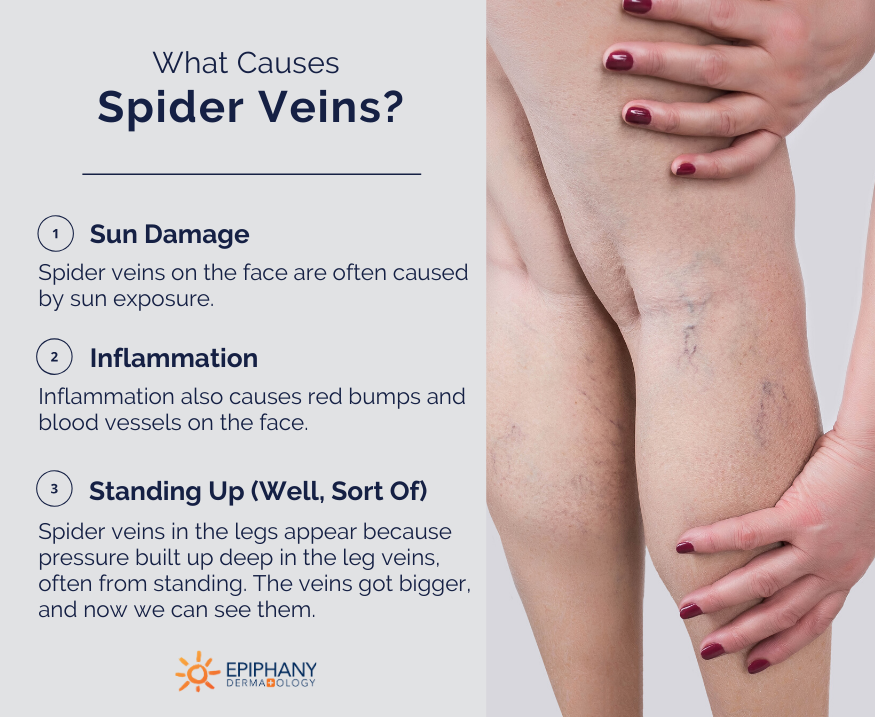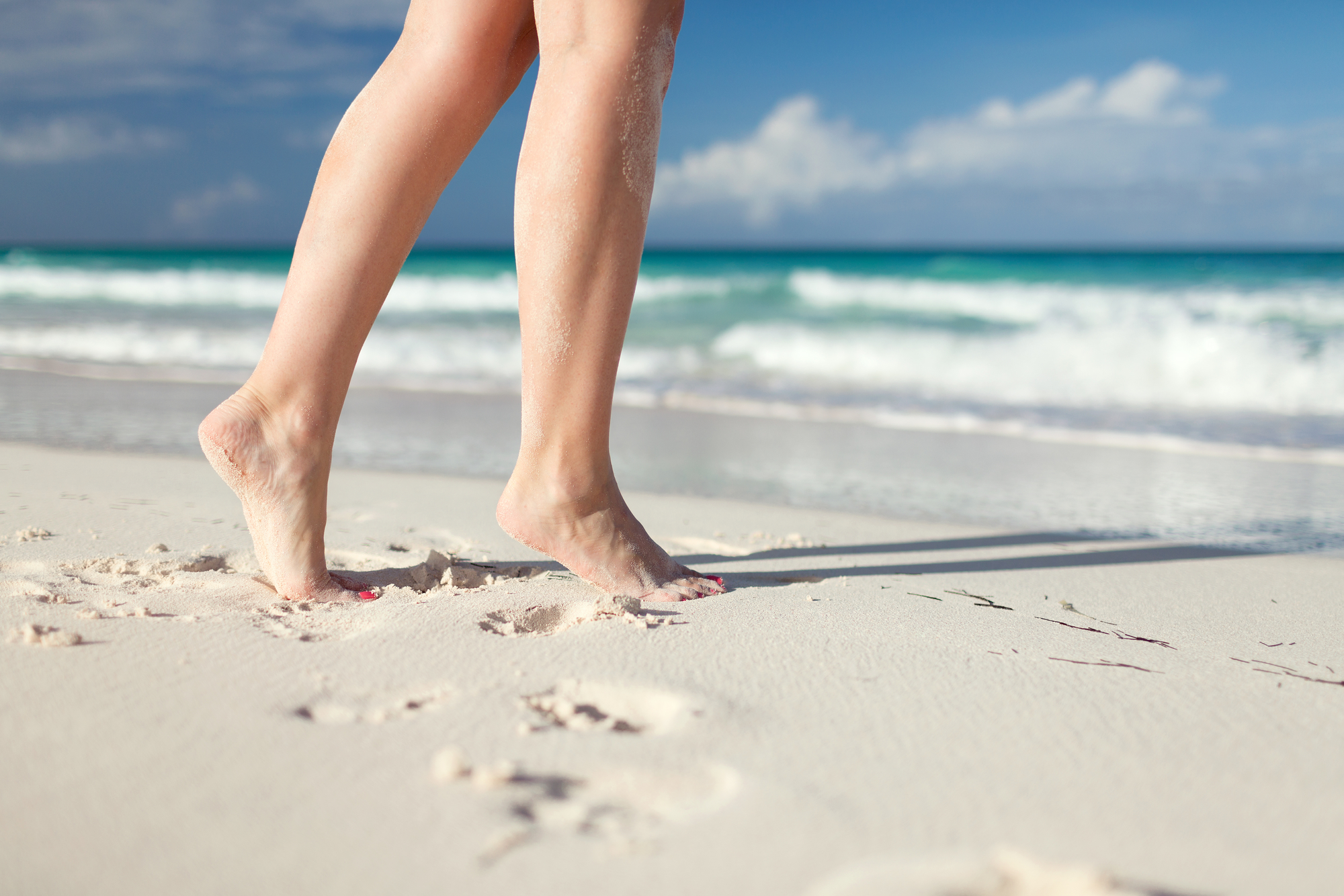Spider veins can creep up on anyone. For some, these veins are a hereditary problem where your valves aren’t working effectively. But for the rest of us, spider veins aren’t dangerous — they’re just unsightly.
While you can’t entirely prevent spider veins on your face and legs – they don’t occur without a genetic predisposition – you can take steps to decrease their appearance.
What Causes Spider Veins on the Face?
Sun Damage
Spider veins on the face are often caused by sun exposure. Sun damage causes the fibroblasts (the skin cells that make collagen) to make less collagen. Then the skin becomes thinner and the blood vessels that were once hidden become visible in the skin.
The blood vessels were always there — they’re simply more noticeable now. Now that our skin is thin, we see spider veins on our cheeks, noses, around the face, or even in the neck. And if your neck starts to stay red after your tan fades, it’s usually because the sun damage is so extensive, the glands in the skin have become visible too.
You can prevent these spider veins with sunscreen. The catch is that you’ve needed to apply the sunscreen for years and once the veins start to show themselves, it’s too late to reverse the damage with sunscreen alone.
Inflammation
Inflammation also causes red bumps and blood vessels on the face. Rosacea is an inflammatory disease of the face, usually on the cheeks and the nose.
It produces skin redness, red bumps, and surfaces little blood vessels called telangiectasias. There’s so much inflammation and swelling that little spider veins get produced in the skin. And even good rosacea medicines don’t reduce blood vessels.
How to Get Rid of Spider Veins on Your Face
Spider veins occur on the face for several reasons. Most commonly, these show due to sun exposure. Sun damage thins the skin and makes blood vessels more visible. Rosacea is another common cause of spider veins on the face.
In both cases, these blood vessels are best treated with a laser. Intense Pulse Light (IPL) treatment effectively diminishes the appearance of these vessels in one or two treatments. Because the laser emits a wavelength of light absorbed by the color red, the energy of the light cauterizes the blood vessel and closes it immediately. Patients notice an immediate improvement in the appearance of their spider veins on the face after treatment.

What Causes Spider Veins on the Legs and Feet?
Spider veins in the legs pop up for very different reasons than those in the face. All spider veins start when blood vessels don’t work correctly. But they malfunction for different reasons. Leg spider veins come because of pressure in the main blood vessels deep inside the leg. When valves in those blood vessels don’t work as well as they should, we see vein problems. For most, these valves are only mildly dysfunctional. So, as the pressure builds, the small capillaries have to absorb some of that pressure. Then the blood vessels grow big enough to see.
People ask, “Did I get these spider veins from standing up too much?” Well, yes, but it’s more complicated than that. Really, they got them because they’re standing up and the pressure built up deep in the leg veins. That pressure was transferred to the superficial blood vessels. The veins got bigger, and now we can see them.
So why does standing up only affect the leg veins? It’s because the blood cells are stacked on top of each other — and that means the veins at the bottom of the body are carrying more of the weight and more of the pressure. Think of these blood cells as a stack of nickels. If you pick up the stack from the bottom, it will be much heavier than if you just take a few from the top. The legs are holding this same type of weight from the bottom, whereas other parts of the body aren’t getting the same pressure. The pressure at the bottom is much greater than it is at the top, causing the spider veins in the legs and feet.
How to Get Rid of Spider Veins on Legs & Feet with Sclerotherapy
If you have a lot of spider veins on your legs, consider seeing a vein doctor who specializes in varicose veins.
However, if you have more superficial veins, a dermatologist can inject the visible veins with a saline solution, called sclerotherapy, that causes spider veins to close and disappear. After the solution is injected into the vein, it strips the lining off the small blood vessel and causes it to scar down. After sclerotherapy, patients must wear compression stockings for up to a month to keep blood vessels supported as they close. Many people find these instructions difficult to follow, which negatively affects their results.
Sclerotherapy is especially effective in the upper leg, but most people don’t bother to treat the little telangiectasias around their feet. Because of the pressure in that area, treatments are only mildly effective.
Spider veins on the legs and feet can also be treated with IPL, but for most of us, the spider veins on our legs are a little too large to respond well to the laser.
If left untreated, spider veins are not dangerous. They’re just unsightly. If you’re ready to make them disappear, visit your dermatologist for a consultation, and they’ll help you identify the best treatment for your spider veins.

Dr. R. Todd Plott is a board-certified dermatologist in Coppell, Keller, and Saginaw, TX. His specialization and professional interests include treating patients suffering with acne, identifying and solving complex skin conditions such as psoriasis, rosacea, atopic dermatitis, and identifying and treating all types of skin cancers. In his spare time, Dr. Plott enjoys cycling, traveling with his wife, and spending time with his children and new grandson.
Learn more about Dr. Plott.

